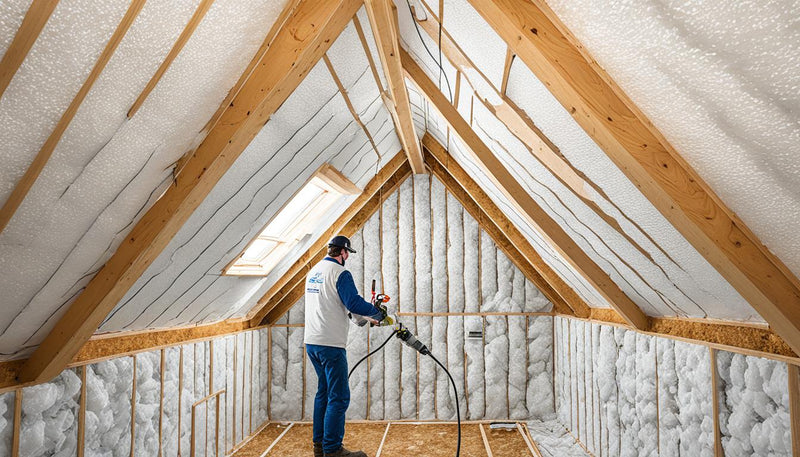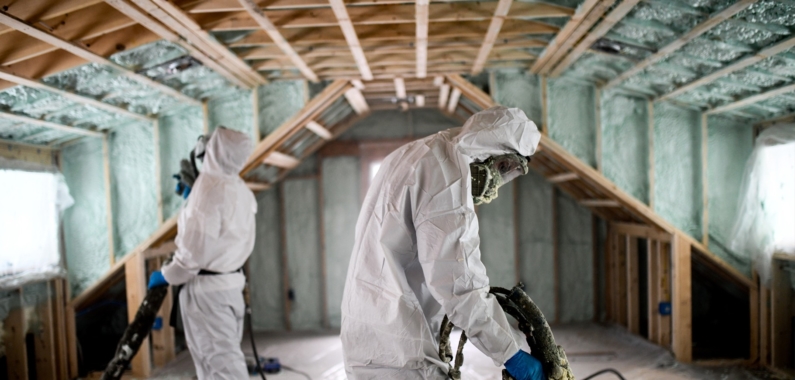How Spray Foam Can Boost Energy Performance in Your Home
How Spray Foam Can Boost Energy Performance in Your Home
Blog Article
Spray Foam: The Ultimate Service for Air Sealing and Insulation
Spray foam insulation has actually arised as a leading service for effective air securing and thermal insulation, using a special combination of properties that set it apart from standard techniques. Understanding the complete scope of its advantages, setup processes, and comparisons with various other insulation kinds is crucial for making educated decisions.
What Is Spray Foam?
Spray foam is a functional insulation product that integrates the concepts of air sealing and thermal resistance to improve power efficiency in structures. Composed primarily of polyurethane or other similar substances, spray foam is applied as a fluid that increases upon contact with surface areas, producing a strong, constant layer of insulation. This special property enables it to load gaps, splits, and voids that standard insulation products might forget, giving an exceptional air seal.
There are 2 major kinds of spray foam: open-cell and closed-cell. Open-cell spray foam is lighter and extra adaptable, supplying exceptional audio absorption and a reduced R-value per inch - Spray Foam. On the other hand, closed-cell spray foam is denser, supplying a higher R-value, wetness resistance, and included architectural stability to constructing parts
The application procedure commonly entails customized devices, making certain a smooth application that sticks to numerous substratums, including wood, concrete, and metal. This flexibility makes spray foam suitable for both new constructions and retrofitting existing structures. Its capability to create a closed obstacle significantly contributes to decreasing power usage and improving indoor air high quality, therefore making it a recommended choice amongst homeowners and building contractors alike.
Benefits of Spray Foam Insulation
Among the most considerable benefits of spray foam insulation is its extraordinary capability to develop a continuous air obstacle, which properly lessens energy loss. Unlike standard insulation materials, spray foam broadens to fill up splits and spaces, ensuring that air leak is drastically lowered. This particular not just boosts energy performance yet likewise causes lower utility costs in time.
Additionally, spray foam insulation supplies remarkable thermal resistance, adding to a much more steady interior setting. Its high R-value per inch enables efficient insulation in constrained spaces, making it suitable for attic rooms, wall surfaces, and crawl areas. In addition, the moisture-resistant homes of spray foam help avoid mold and mildew growth, advertising much healthier living conditions.
An additional important advantage of spray foam insulation is its sound-dampening qualities (Spray Foam). It successfully minimizes noise transmission between rooms, producing a quieter and a lot more comfy home setting. The toughness of spray foam additionally stands apart, as it does not sag or clear up in time, maintaining its efficiency throughout its lifespan
How Spray Foam Works
Recognizing exactly how spray foam insulation works is important for appreciating its effectiveness in air securing and thermal resistance. Spray foam insulation includes two main components: isocyanate and polyol resin. When these parts are combined, they undergo a chemical reaction that causes the product to increase swiftly, producing a thick foam that loads voids, cavities, and fractures.
As the foam expands, it complies with surface areas, developing an airtight seal that considerably decreases air infiltration. This particular makes spray foam insulation very reliable at avoiding drafts and dampness penetration, which can lead to power loss and damage over time. Additionally, the closed-cell version of spray foam provides superior thermal resistance because of its rigid structure, efficiently decreasing warmth transfer.
The unique residential or commercial properties of spray foam allow it to comply with irregular surface areas, ensuring detailed insurance coverage and a seamless barrier. Therefore, spray foam insulation not only improves power efficiency but also adds to enhanced interior air quality by reducing the build-up of irritants and contaminants. Ultimately, recognizing the mechanics behind spray foam highlights its duty as a superior choice for insulation and air sealing in both residential and business applications.
Setup Process Review

Prior to installment, the room needs to be effectively cleaned up and prepped, ensuring that surface areas are devoid of dampness, dust, and particles. This action is vital due to the fact that contaminants can endanger bond and general efficiency. When the area is prepared, the application involves blending both components of the spray foam, which expands upon contact and fills spaces successfully.
Educated experts need to conduct the setup, using specialized equipment to guarantee consistent coverage and optimum density. Safety safety measures, consisting of using protective equipment and guaranteeing proper air flow, are vital throughout this process. After application, the foam commonly cures quickly, developing a solid obstacle that enhances power efficiency.
Comparing Spray Foam to Standard Insulation
When reviewing insulation options, spray foam insulation stands apart in comparison to standard products such as fiberglass and cellulose. One of the key benefits of spray foam is its exceptional air sealing abilities. Unlike fiberglass and cellulose, which can enable air seepage, spray foam increases upon application, filling spaces and holes to produce a closed seal. This leads to boosted power efficiency, as much less heated or cooled air escapes the home, resulting in reduced utility costs.
In addition, spray foam offers a greater R-value per inch than traditional insulation types, using more effective thermal resistance in a thinner account. This characteristic click here to read is especially beneficial linked here in spaces with minimal cavity depth. Spray foam is resistant to moisture and mold and mildew growth, which can be a significant concern with cellulose and fiberglass, specifically in damp settings.
Nevertheless, spray foam insulation typically lugs a greater upfront cost than its typical counterparts. Property owners have to consider this preliminary investment versus lasting power cost savings and efficiency advantages. Ultimately, while both insulation types serve their function, spray foam arises as a more sophisticated solution for modern-day insulation needs, specifically in regards to air sealing and thermal performance.

Final Thought
In summary, spray foam insulation stands for a highly efficient solution for accomplishing optimal air securing and thermal resistance. Its unique properties, including moisture resistance and audio dampening, make it suitable for different applications in both brand-new constructions and retrofitting jobs (Spray Foam). Although the initial prices might be higher compared to conventional insulation products, the lasting benefits, such as significant energy financial savings and improved indoor air top quality, validate the financial investment and emphasize its worth in modern structure practices.
Spray foam insulation has actually arised as a leading solution for effective air securing and thermal insulation, supplying a distinct mix of buildings that set it apart from typical techniques.Spray foam is a flexible insulation product that combines the principles of air sealing and thermal resistance to improve energy efficiency in structures.When assessing insulation alternatives, spray foam insulation stands out in contrast to typical materials such as fiberglass and cellulose. Eventually, while both insulation kinds serve their objective, spray foam arises as an extra sophisticated remedy for modern insulation requirements, specifically in terms of air securing and thermal effectiveness.
In summary, spray foam insulation represents a highly reliable option for accomplishing optimal air securing why not find out more and thermal resistance.
Report this page